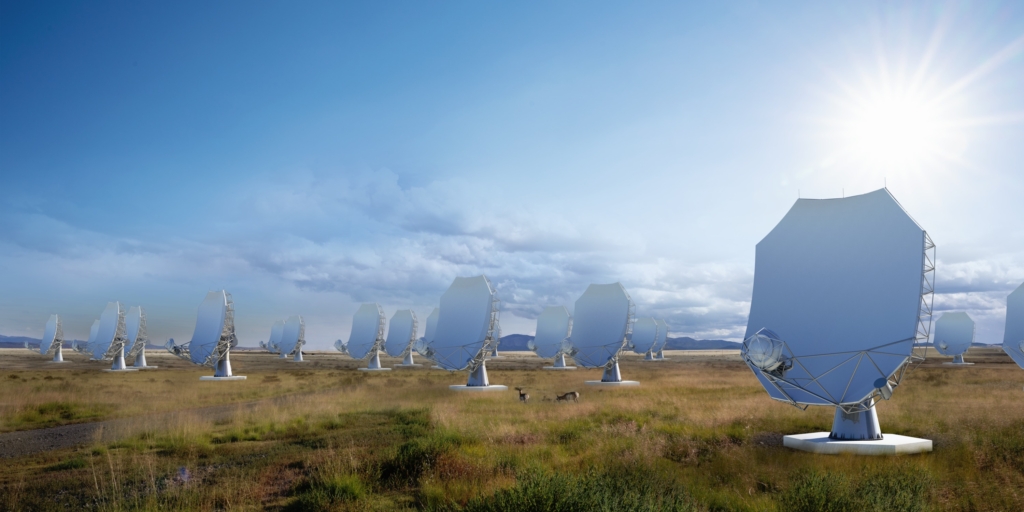The [CII] Resolved ISM in STar-forming galaxies with ALMA (CRISTAL survey) peered back to when the Universe was only about one billion years old – a mere toddler in cosmic terms. These observations are helping scientists understand how galaxies formed and evolved from primordial gas clouds into the organized structures we see today.
Recent News
NSF NRAO Leads Critical Spectrum Studies to Safeguard Radio Astronomy
The U.S. National Science Foundation National Radio Astronomy Observatory (NSF NRAO) has received funding to expand its study of an invisible—and crucial—scientific and technological resource: the radio spectrum.
Largest Oort Cloud Comet Ever Observed Reveals Its Secrets with ALMA’s Powerful Gaze
A team of astronomers has made a groundbreaking discovery by detecting molecular activity in comet C/2014 UN271 (Bernardinelli-Bernstein)—the largest and second most distantly active comet ever observed from the Oort Cloud.
$21 Million NSF Award Will Bring ngVLA Design to Life

The largest astronomical array in North America is one step closer to becoming a reality. The National Radio Astronomy Observatory (NRAO) is pleased to announce that the National Science Foundation (NSF) has awarded a 3-year, $21 million grant to Associated Universities, Inc. (AUI) to further the design of the next generation Very Large Array (ngVLA). Said Tony Beasley, Director of NRAO, “Despite challenging economic times, this award demonstrates a strong commitment from the research community and the NSF to create astronomy’s next great instrument, and continue U.S. radio astronomy leadership. NRAO is committed to begin construction of the ngVLA later this decade.”
Late this summer, the NSF formally entered the ngVLA project into the Major Research Equipment and Facilities Construction (MREFC) design process at the Conceptual Design Phase. The NSF-led Conceptual Design Review (CDR) is expected next Spring and will be supported by this most recent award. While this does not yet represent a commitment to construct the telescope, the review signals the project’s strong scientific and technical promise and growing project readiness. The three MREFC reviews (Conceptual, Preliminary, and Final) will provide NSF with the critical information needed to consider adding ngVLA construction to a budget request later this decade.
The concept for the ngVLA was created in 2016, and the telescope was presented to the ASTRO2020 Decadal Survey in 2019. Delivery of the ngVLA prototype antenna to the VLA site is expected in summer 2024.
The National Radio Astronomy Observatory is a facility of the National Science Foundation, operated under a cooperative agreement by Associated Universities, Inc.
This news article was originally published on NRAO website on September 14, 2023.
Recent News
ALMA Reveals Stunning Details of Infant Galaxies in the Early Universe
The [CII] Resolved ISM in STar-forming galaxies with ALMA (CRISTAL survey) peered back to when the Universe was only about one billion years old – a mere toddler in cosmic terms. These observations are helping scientists understand how galaxies formed and evolved from primordial gas clouds into the organized structures we see today.
NSF NRAO Leads Critical Spectrum Studies to Safeguard Radio Astronomy
The U.S. National Science Foundation National Radio Astronomy Observatory (NSF NRAO) has received funding to expand its study of an invisible—and crucial—scientific and technological resource: the radio spectrum.
Largest Oort Cloud Comet Ever Observed Reveals Its Secrets with ALMA’s Powerful Gaze
A team of astronomers has made a groundbreaking discovery by detecting molecular activity in comet C/2014 UN271 (Bernardinelli-Bernstein)—the largest and second most distantly active comet ever observed from the Oort Cloud.
